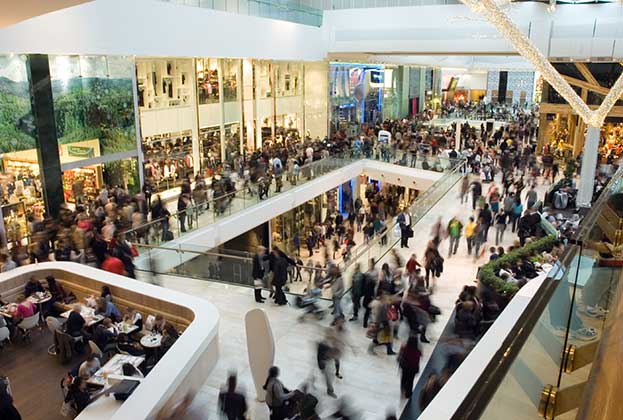Tightening consumer finances dampened retail sales in 2023, but stronger performance forecast for 2024
With the weight of inflation, consumer confidence well below its long-term average, and an increase in interest rates in most European markets, consumers are restricting spend in some areas as their disposable income is squeezed. As a result, total retail sales for Europe are forecast to marginally decline by -0.1% in real terms in 2023. But, while macro-economic headwinds have been particularly acute this year, conditions look set to improve.
Firstly, the recession in Europe looks set to be avoided this year with 0.5% GDP growth forecast, accelerating to 0.9% in 2024. The strength of the labour market has also helped to sustain the European economy, with unemployment at record lows; the EU unemployment rate is expected to hit 6% in 2023, down 20 basis points (bps) year-on-year, the lowest unemployment rate seen since the global financial crisis (GFC). Finally, fiscal tightening has eased headline inflation across Europe, with CPI forecast to be 4.9% in the EU-27 in 2023, down from 9.2% in 2022.
These evolving market conditions indicate an improved retail sales outlook for the coming year, particularly as the squeeze on real disposable incomes dissipates, with forecasts for European spend in 2024 pointing to a rebound with growth of 3.7% (real terms).
But some markets bucked the wider European trend of weaker retail sales this year. Ireland is expecting year-end sales growth to hit 4.6%, with a further 2.8% growth in 2024. The Southern European markets of Spain, Portugal and Italy are also expected to report positive growth by the year end of 1.7%, 1.2% and 0.4%, largely the result of lower inflation and returning tourism boosting sales, particularly in the luxury market. A stronger rebound in performance for Spain and Portugal is forecast for next year.
Consumers spending priorities evolve
While total retail sales have been under downward pressure this year, this has not been reflected across all parts of the retail market. Tightening consumer finances have buoyed discount and convenience-driven retail spend, as consumers look to make savings on everyday items and head for cheaper retail options.
Recent spend on fashion has also been impacted by the evolving consumer environment, with the sub-market projected to increase by only 0.2% this year, despite recovering to its pre-pandemic levels in 2021. However, waning headwinds to consumers’ discretionary spend in 2024 suggests fashion spend will strengthen with a growth of 3.7% forecast.
But again, headline performance only tells part of the fashion spend story. The mid-market has been more exposed to this year’s ‘squeeze’. Mass or value fashion has, on the whole, continued to perform well, albeit with slower growth rates than seen in 2022. For example, Primark reported year-end sales in September up 17%, with Zara also posting a 13% year-on- year growth for the first half of 2023.
This relatively strong performance has also been mirrored at the premium and luxury end, with Bain-Altagamma forecasting that personal luxury goods spend in Europe in 2023 was 8.1% above that seen in 2019, with forecasts to 2030 suggesting a further 33% increase. This has been helped by not only the resumption in international tourism, but also accrued pandemic savings that, despite a de-winding from their pandemic highs, remain above pre-pandemic levels. According to the European Central Bank (ECB), overnight household deposits in September 2023 were still 22% above equivalent 2019 levels, albeit down from the 36% differential reported at the start of the year.
The prioritisation of spend in the luxury part of the market by certain consumers is also being seen in the ‘experiential’ space. Leisure and food and beverage (F&B) sectors continue to be resilient across many markets, with spend within the sector, accounting for 54% of total European retail sales to date, unchanged from its 2022 share, with this share to increase to 55% in 2024. We have seen a similar trend when it comes to leisure travel within Europe, due to many households looking to reduce spend elsewhere in order to protect holiday trips and spend.

Omnichannel strategies mean physical stores are being increasingly prioritised
The share of e-commerce in Europe is predicted to grow to 15% in 2024 from 14% in 2023; 28.4% of fashion spend in Europe is forecast to be online in 2024, up from 17.1% in 2019. However, there are parts of the retail market where the rate of penetration is much higher or much lower.
While the rise of online has had a significant structural impact, its readthrough to occupational markets varies across different geographies. For example, in Southern Europe, where the online penetration rate is relatively lower, its impact has been less pronounced, with overall vacancy rates remaining relatively low, though they are on the increase for secondary and tertiary retail locations.
Since the pandemic, evolving omnichannel strategies – where e-commerce complements physical store performance and visa-versa – is resulting in prioritisation of store portfolios by retailers. This is manifesting through upsizing in key markets and targeted expansion, and has been exacerbated by the rise in online customer acquisition costs and those associated with online deliveries/returns. What has not changed post-pandemic is the fact that prime and super convenient retail locations are benefitting from this strategy.
Read the other articles within European Retail Market below
.jpg)



.jpg)


